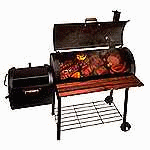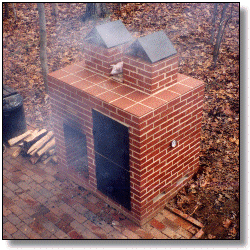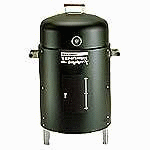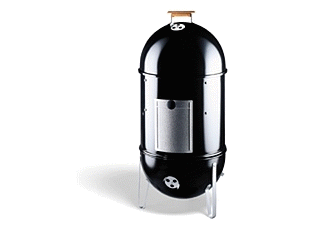|
Choosing a
Smoker If you are new to the world of
real barbecue you are likely to be astonished by the wide array of smokers available to
the home enthusiast. I know I certainly was when I made my initial forays into a
world of terminology, contraptions and heated argument, all of which sounded completely
foreign to me. Once you learn a few of the basics however, you will readily able to
distinguish among the different types of hardware and make a choice as to which is the
best for your needs.
The
Basics
Smokers, the generic term applied to the box
in which the meat is cooked, consists of the same essential elements even though they may
be configured differently to suit conditions, quantity, heat source, aesthetics, etc.
- They all contain a heat source.
The source may be a firebox for burning wood, a container for charcoal or
electrical heating elements.
- They all have a cooking chamber.
The cooking chamber is where the meats will sit, usually on grates or spits, during
the smoking process. It must be capable of temperature regulation and it must be
positioned so that smoke can enter the chamber and surround the meat.
- Another aspect of a smoker is that the heat
source and the cooking chamber are always configured such that the meat is cooked indirectly.
In a smokehouse configuration the firebox (heat source) is usually on one side of
the smoker while the cooking chamber is on the other (horizontal design.)
In a water smoker, the meats sit above the heat source, but are
separated by a water pan. The heat
is directed to the cooking chamber through the use of baffles and vents. The meats
never are in direct contact with the heating source.
- The cooking chamber must have adequate
ventilation. Properly configured a smoker will have a ventilation system that
allows smoke to be drawn from the heat source, pulled into the cooking chamber where it
surrounds the meat and vents that allow the smoke and moisture in the cooking chamber to
be vented out in a controlled fashion. Beyond those basic elements everything else
relates more to convenience, capacity and the personal whims of the pitmaster than to the
results it will yield.
Most smokers made for the home come in two varieties: those that are designed
horizontally (often referred to as wood smokers), and those that are designed
vertically (water smokers.)
Wood Smokers
 So called because the size and design of these
smokers allow for using wood logs as the heat source. This is both in keeping with
tradition as well as allowing the pit master to harvest, or at least select, the fuel with
just the right burning and flavoring qualities to suit his or her particular taste. So called because the size and design of these
smokers allow for using wood logs as the heat source. This is both in keeping with
tradition as well as allowing the pit master to harvest, or at least select, the fuel with
just the right burning and flavoring qualities to suit his or her particular taste.
The picture to the left is a smoker made by the Brinkmann Corporation and is quite
typical of the "portable" smokers available to backyard barbecuers. The
firebox (heat source for this type of smoker) is located to the left. Note that it
is configured so that the fuel can be accessed without opening the cooking chamber,
thus
allowing heat to escape. The single level cooking chamber is obvious by the goodies
currently on the cooking grate and the chimney (cooking chamber vent) can be seen on the
right rear of the unit.
To the right is the "Wilbur D. Hog". A do-it-yourself project that is
much fancier and, obviously, a lot less portable than the Brinkmann, but essentially the
same. Note the firebox door on the left and
the door to the cooking chamber is to the right. The chimneys provide ventilation. Beside these two examples there are dozens of
manufacturers of home smokers, including many do-it-yourself kits for the truly dedicated.
They can range from a couple of hundred to many hundreds of dollars. door on the left and
the door to the cooking chamber is to the right. The chimneys provide ventilation. Beside these two examples there are dozens of
manufacturers of home smokers, including many do-it-yourself kits for the truly dedicated.
They can range from a couple of hundred to many hundreds of dollars.
They will all get the job done. Some
factors to consider are:
- portability - do you want to take the
smoker to the next family reunion? Or forever host it at your place?
- capacity - 8-10 pounds of spare ribs
will easily fill up a cooking grate. The same space should allow room enough room
for 3-5 pound butts or 4-31/2 pound chickens. This may sound like a lot but doesn't
cut it for a large gathering.
- flexibility - having a second cooking
grate in the cooking chamber is great. It expands your capacity and increases
flexibility.
Water Smokers
Arguments have raged for decades as to the
necessity of introducing additional moisture into the smoker (see Barbecuing Techniques). While it may seem
that water smokers would be the invention of the pro-moisture set, they were really
designed to provide a highly portable, inexpensive, space saving alternative to wood
smokers.
In a water smoker, such as the Brinkmann Sportsman pictured to the left, the essential
design is vertical rather than horizontal. The heat source, either a charcoal
container or electrical coils are located at the bottom. Above that sits a water pan
separating the heat from the cooking chamber above. The water pan prevents the meat
from being exposed directly to the heat source (remember indirect cooking?) and makes this
vertical design possible. These smokers have a smaller footprint than regular grills,
which make them ideal for decks or back porches. They are also modular and break
apart easily for transporting to your next outing. By the way they can be
reconfigured to function as grills (except the electric models).
Aside from design considerations the water pan ensures a constant amount of
moisture in
the cooking chamber. This combines with the smoke particles to coat the meat,
sealing in the juices, while providing the meat with constant basting. The water can
be spiked with, or replaced by, all sorts of flavorings from herbs and spices to beers and
wines. A very nice added benefit. The capacity of the water smokers is
certainly adequate although it cannot approach the wood smokers in this regard. The Brinkmann Sportsman claims a 50 pound capacity but my experience suggests 30 pounds is
more like it. Nevertheless, that feeds a lot of hungry people.
Recommendations
Want to play around first? Before you decide? Well, if you have a kettle
grill (see Grilling) you can produce some satisfying barbecue
without anything else to purchase. You can't barbecue large quantities, but you can
certainly determine if this is something worth further investment. Set up your
kettle grill for indirect cooking with the coals to the sides, meat in the middle set over
a water/drip pan placed at the bottom of the kettle. Adjust your vents to get the
temperature down into the smoking range (200 to 225 degrees), sprinkle some soaked wood
chips on the coals, close the lid and, viola!
Mock barbecue! on the coals, close the lid and, viola!
Mock barbecue!
Of course it won't duplicate all of the advantages of a real smoker, but for small
quantities you'll be wonderfully surprised.
Pictured to the right is the Weber Smokey Mountain water smoker, and this is what I've
used for years. It is considered to be a Cadillac among water smokers and costs
about three times what the Brinkmann Sportsman (above) costs. I have had nothing but
success, and would recommend it to anyone.
With that said, however, it is not what I generally recommend to
people just starting out. Learning to smoke food properly is a commitment,
and
it's not just the learning process. Many enthusiastic first timers find themselves
put off by the time it can consume. It's not that you have to tend a smoker every
minute, but it does take a lot of minutes. One 3-1/2 pound chicken takes 3-4 hours
not including setup time. Want to have pulled pork barbecue for dinner? Most
of your Saturday will be consumed. For this reason I direct first timers to the best
combination of easy-to-use and low price. If you find yourself losing interest you
don't want hundreds of dollars tied up.
For the tentative among you I recommend an electric fired water smoker. Brinkmann
makes an excellent, entry level model for about $100. Using an electric model takes the guess work
out of controlling the temperature (the critical factor in good barbecue, and the
hardest element to master) while minimizing your investment. It is highly portable
to boot. If you find yourself in barbecue-love you can always go hog wild
(sorry, couldn't help myself) later, and build the ultimate pit in your backyard.
You'll still find yourself using the water smoker from time-to-time.
Still have questions? You can
e-mail me
and I'll be glad to answer them for you if I can.
Good Barbecue To You,
Big Daddy |
![]() Big
Daddy's Kitchen
Big
Daddy's Kitchen